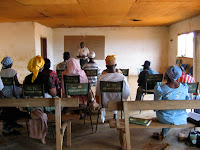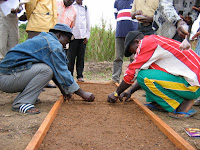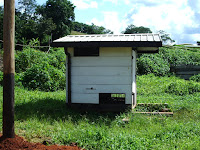It’s the anniversary of two years in Cameroon today! I should be thrilled, but I’m actually extremely upset. In fact, after my visit to the sawmill today, I went to Magloire’s house after and cried and threw a small fit. I’ve said it before (perhaps not to but I really many people in particular, but to myself, at least) and I’ll say it again: I feel like Cameroon has broken me – my hope, my spirit, my optimism for humanity. That may sound drastic, but perhaps it feels so much worse, because I don’t feel like even my best friend here can understand why I’m upset and comfort me properly. Magloire’s response to my being upset was “Becca, you know how things work here, so why are you letting it upset you?” This is so Cameroonian - ie when everything goes wrong, it’s your fault for being upset about it. Geez, I’m just looking for a little sympathy. I even tried to explain that to him before I became a blubbering mess, but once again, I don’t think he understood that all I really wanted to hear was comforting sounds - “I know, they suck, those bastards.”
I guess I should backup and explain what brought this on. While preparing breakfast this morning, Magloire surprised me by showing up at my house. He was supposed to be two days travel away at a training that was supposed to begin yesterday for a government-sponsored project he’s doing. Apparently, this training has been rescheduled for next week, for the same dates as those for our HIV Counselor Training. Now we’ve got to figure out a way to manage this problem, and he’s talking about skipping out on part of our project. I feel confident that I could lead the training alone, but 1) I think it will be more beneficial for participants if he’s there to act as a cultural liaison; 2) I think he will benefit from teaching, it will be a good experience for him; 3) He made this commitment months ago, and I feel like it’s unfair to drop that commitment a week beforehand because some jerk government organization finally got their shit together and planned their project for the same time as we did.
So that was problem number 1. Actually, that’s problem number 3. Problem 1 is the seeming impossibility of getting HIV tests for our HIV week project. I have about next to no faith that I’ll be able to get tests from the government agencies responsible for distributing them. I already know that the Cameroonian government is entirely inept, corrupt, inefficient, and basically incapable of doing anything but put on airs and bouffe money. Perhaps because I wasn’t expecting much from them, this is less disappointing, despite the fact that free testing was kind of the culmination of AIDS Week. I’ve approached other NGOs to try and get HIV tests, to no avail. I actually wonder whether there are any tests physically in the country right now.
Problem 2 is ACMS (Association Camerounaise pour le Marketing Social), a Cameroonian NGO that distributes a lot of HIV and malaria related materials as one approach to combating these two large health challenges. ACMS has long been a reliable partner for PCVs, providing sponsoring for PCV projects. I visited ACMS about a month ago with Magloire, and they gave us the runaround – making us re-write and re-deliver our demande d’aide, fill out additional forms, and then come back on a Friday, (but not the following Friday, when I would conveniently still be in Yaounde). When I thus went back last Friday, I was irritated when the receptionist said that they didn’t currently have anything to give out. Could I come back on Monday or Tuesday? “No!” I wanted to scream, “This is my third trip here! You shouldn’t make promises you can’t keep. If you can’t give me anything, can you just say no, so I stop wasting my time?!” But I didn’t say that, I politely informed her that I could not come back the next week because I was traveling back to Ngambé Tikar the next day (Saturday). She said I could send someone in my place, so I enlisted a PCV friend, Ben.
When I called Ben yesterday to see if he had success, he said that the ACMS office was closed on Monday. I couldn’t believe the receptionist would tell me to come back when the office was closed! Was that her way of telling me to stuff it? Or was she actually that stupid and inconsiderate? Clearly, this has angered me. I thought ACMS was reliable – last year, during international AIDS day, it was almost absurd how easy it was to get HIV materials, such as condoms and posters. Many volunteers have successfully gotten sponsoring from ACMS. I now wonder if I did something wrong?
And now for problem 4, which basically triggered my emotional breakdown today. Before I went to Yaoundé last week, I asked Mirko at the sawmill if he had the money that he had promised us for this project – 150.000 CFA, or about 12% of the overall budget, no small contribution. He said he didn’t, but I should come back on Monday and he would have it then. I said I wouldn’t be in village, and he agreed that Magloire could pick up the money. When I called Magloire from Yaoundé so find out if he had gotten money from Mirko, he said no. I encouraged him to be persistent, thinking it was just a problem of reminding Mirko enough times (not unusual here).
When I went to talk to Mirko today, I was not expecting what he told me, which was that he had no money (how that’s even possible – the sawmill just built a brand new office… I don’t want to get into). So basically, he just made a promise, which he may or may not have intended to keep. I can’t believe it. I don’t think a company could get away with that in America – the media backlash would be awful for business. But not in Cameroon! I’m so disgusted with the way this country functions. Which is actually an oxymoron – this country doesn’t function.
In short, everything that could go wrong with the AIDS Week is… and all of it is out of my control, but yet reflects on me. I think this is why I’ve had such trouble with Cameroon, in general: maybe you’ll achieve something great which has little to nothing to do with your particular effort. And maybe you’ll try and try and try to do something meaningful and the end result will be pitiful. It makes you wonder why you should even try since results seem to be so unrelated to effort.
Actually this whole mess has brought me some peace on an issue that has been challenging for me to grope with. Namely, how much does the West owe to Cameroon and to Africa in monetary terms? Should the wealthy West be throwing more money at Africa’s enormous and seemingly insurmountable problems? Should we pity their poverty – their kids’ bellies swollen from malnutrition, their mud brick houses with leaky thatched roofing and dirt floors, their lack of clean drinking water, their endemic malaria? I think I have finally found an answer: no.
If there’s anything to pity here, it’s the overwhelming and stifling lack of hope and sense that people have no power to influence fate, embodied perfectly in that all too common phrase, “on va faire comment?” (“What are you gonna do?”) Because no matter how poor, sick, hungry, or suffering these people are in material concerns, they are far richer in closeness of family and generosity to fellow man (something America could certainly take notes on…). Moreover, if America teaches us anything, it’s that perseverance and hard work can achieve anything, but you must first believe in your ability to succeed. This is something kids are trained to believe since pre-school – who didn’t grow up hearing, “What do you want to be when you want to grow up? You can be anything you want, you just have to try!” All of Africa’s (okay, perhaps I shouldn’t generalize to a whole continent, but definitely Cameroon’s) problems, I firmly believe, could be resolved if people – forgive the cheesiness – had the audacity to hope. Hope, the belief in the very possibility of better, is truly powerful. It can lead people to do extraordinary things – just as it is bringing much-needed health reform to America’s ailing health care system right now. But Cameroonians don’t have this vision. Today, I felt the way they see the world, I understood that lack of hope, fundamentally and viscerally. Why do I care, why do I even try when everything is just as likely to fall apart as it is to work?
No. Don’t pity Africans their poverty. Pity them the colonialism, the traditions, and resulting clusterfuck of disorganization that many countries on the continent have suffered and which crushes hope of making a difference insidiously, beginning with early childhood, until the people become docile and incapable of getting angry in the face of injustice, chalking everything up to fate.
On va faire comment?















































